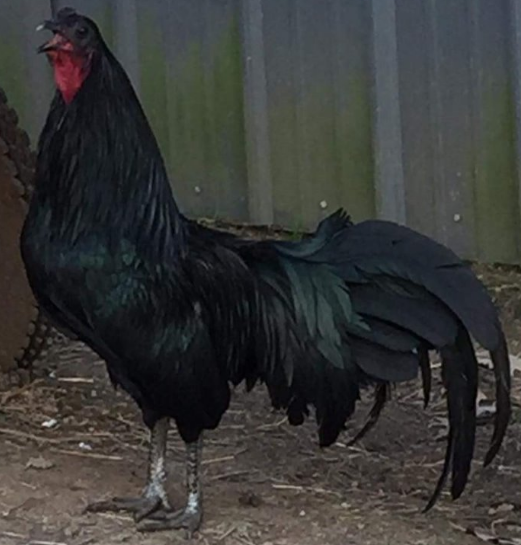
If you have ever seen the Sumatra chicken, you were probably struck by its flair for the dramatic, boasting shiny, lustrous plumage and a poised, upright stance immediately drawing the eye.
The Sumatra is a beautiful chicken, without a doubt. Still, it also has an exciting history that weaves together its exotic origins and the curiosity it ignited among cock fighters and breeders alike.
Where does the Sumatra chicken originate? The Sumatra chicken hails from an origin steeped in rarity, with strains of the wild echoing in its lineage.
Consider the names it’s known by and the cultural encounters it has had. These aliases hint at a bird not confined by borders but celebrated across seas.
- Sumatran Pheasant
- Black Yokohama
- Java Pheasant Game Bird
Centuries might have turned since the Sumatra chicken first caught the attention of humans, yet a unique duality marks its past.
While once a fierce contender in cockfighting, renowned for its agility and spirit, the Sumatra never quite reached the zenith of this ancient sport. Yet, this same spirit now captivates a more peaceful audience as the bird prances with pride in modern showings.
Today, my appreciation goes beyond the functionality or utility of the breed. It encompasses the aesthetic joy it brings, down to the striking detail of the yellow footpads that contrast against the dark plumage, black skin, and bones.
Other breeds that have black skin and bones include the Silkie and the Ayam Cemani.
A pause to consider such a distinct feature invites contemplation on what sets Sumatra apart, urging breeders and backyard flocktenders alike to learn more.
The History and Selective Breeding of Sumatra Chickens
A look into poultry history reveals that the origins of the Sumatra chicken breed are compelling and obscure. This bird, known for its glossy, lustrous plumage and poised demeanor, heralds from the tropical environs of the Indonesian island of Sumatra.
Charting its journey to Western shores, its introduction to the United States dates back to the mid-19th century, a testament to its lasting appeal.
While commonly celebrated for its decorative flair today, the Sumatra chicken was not always a mere showpiece.
In its native land and early records, the Sumatra was esteemed for its prowess as a fighting bird, a testament to its spirit and endurance.
However, it didn’t rise to prominence in the competitive cockfighting rings. Its smaller size of about 4 pounds for a rooster ultimately dissuaded breeders from choosing it for battle, marking the beginning of its evolution from a fighter to an admired ornamental bird.
As the tides of time have turned, the Sumatra chicken’s function has undergone a fascinating metamorphosis.
What initially began as an inclination towards the bird’s utility and sport has gradually given way to an appreciation of its beauty and stature.
At present, Sumatra chickens grace exhibition halls far more than fighting arenas, securing their status as ornamental treasures within the avian community.
While their fighting days are essentially a relic of the past, remnants of their combatant lineage are visible in Sumatra’s physical traits. Their multiple spurs, a cascade of lustrous tail feathers, and a combative stance are telltale signs of their ancestral vigor.
These characteristics catch the eyes of judges and breeders alike, rather than opponents in the ring.
Practical Insights – Rearing Sumatra Chickens
If you’re entertaining the idea of adding Sumatra chickens to your flock, there are several practical aspects you’d do well to consider.

This breed isn’t just a pretty face; its characteristics span a range of utility and aesthetics, which you must understand for optimal care and management.
Starting with purpose, Sumatras aren’t typically seen as layers or meat birds. They are more of a show breed. Their contribution to egg production is limited. They lay a modest number of eggs with the eggshell color ranging from a light tint to white.
As for size, Sumatra chickens are reasonably sized. Adults usually weigh around 4 to 5 pounds, with males slightly larger than hens. This gives them a lean, sleek profile that their long, flowing tail feathers accentuate.
Concerning their egg-laying capacity, don’t expect your coop to overflow. Sumatra hens lay about 50 to 100 small eggs per year.
Comparatively, this is low, so if you’re looking for a robust egg producer, Sumatras might not be your top choice. But what they lack in quantity, they make up in the charm and rarity of their eggs.
Sumatras excel in adapting to warmer climates thanks to their Southeast Asian roots, making them heat-hardy. However, they’re not renowned for cold tolerance, so you’ll need to ensure adequate shelter and warmth during the chillier months.
In terms of temperament, Sumatra chickens display a confident disposition. They are alert and active, often showing a spirited independence.
They may not be the cuddliest addition to your farm, but their elegance and demeanor can bring a new dynamic to your backyard.
For those who prefer chickens that seek out their food, Sumatras are competent foragers. They appreciate space to roam and will take advantage of it, often seeking their sustenance with little dependence on feeders.
Sumatras are pretty robust regarding health, showing a decent resistance to many common poultry diseases. Nevertheless, keeping their living area clean and monitoring them for signs of illness is crucial.
Finally, special care needs shouldn’t be a deterrent. They require regular health checks, a well-balanced diet, and protection from predators due to their lightweight bodies and attractive plumage, which can make them a target.
Also, their love for roaming means they need secure space to prevent unexpected escapes.
Concluding Thoughts on the Flighty, Fighty Sumatra Breed
After looking into the specifics of the Sumatra chicken, it’s clear this breed is not your average backyard fowl. With its rich history and striking aesthetics, the Sumatra stands out as a breed with deep roots and a character all its own.
One attribute that needs to be mentioned is that these birds can fly. I don’t mean you might find them atop your barn. You might find them across the valley or the meadow, depending on where you live.
They are considered a standard chicken but have many of the attributes of a bantam. This makes them susceptible to predators, so you’ll want to keep an eye on them.
The Sumatra chicken can be a captivating addition to your flock. Given their unique temperament, climate resilience, and foraging proficiency, they offer a distinct experience for the right keeper.
Their fighting past may define much of their history, but today, Sumatras are more about show than combat. The beauty and grace of these birds make them perfect for exhibitions and for those who appreciate ornamental poultry.
However, it’s essential to consider if you’re prepared to meet their specific care needs before bringing Sumatras into your coop. As with any rare breed, dedicated attention to their health, space, and dietary requirements is critical.
In crafting a conclusion about the Sumatra chicken, we see a bird that’s more than a flash of feathered splendor. They are remnants of a storied past, modern-day showstoppers, and, if conditions allow, possibly a remarkable addition to your aviary ensemble.
As always, thanks for stopping by. Leave any questions or comments you have below and I’ll get back to you as soon as I can.
Take good care of yourself.
Dave
Chickenmethod.com
